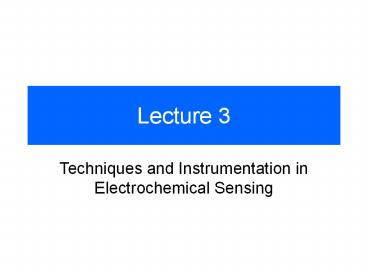Techniques and Instrumentation in Electrochemical Sensing - PowerPoint PPT Presentation
Title:
Techniques and Instrumentation in Electrochemical Sensing
Description:
Lecture 3 Techniques and Instrumentation in Electrochemical Sensing Cyclic voltammetry for reversible reaction Cyclic voltammetry initial situation Cyclic voltammetry ... – PowerPoint PPT presentation
Number of Views:548
Avg rating:3.0/5.0
Title: Techniques and Instrumentation in Electrochemical Sensing
1
Lecture 3
- Techniques and Instrumentation in Electrochemical
Sensing
2
Cyclic voltammetry
- for reversible reaction
3
Cyclic voltammetry
- initial situation
- formal potential reached in forward scan
- max. current
- formal potential reached in reversed scan
4
Cyclic voltammetry
- The peak current for a reversible system is given
by Randles-Sevcik equation
A in cm2, C in mol/cm3, D cm2/s, v in V/s.
- The formal potential for a reversible couple
5
Cyclic voltammetry
- In the case of adsorption process on the
electrode, the separation between the peaks will
be smaller and current will be proportional to
the adsorption
6
Spectroelectrochemistry
- Optical techniques, e.g. spectroscopic adsorption
can be coupled to e/chemical methods
7
Chronoamperometry
- involves stepping potential of the working
electrode from a value when no faradaic current
occurs to a potential at which the concentration
of electractive species becomes zero - Response described by Cottrell equation
first 50ms contribution of charging current
- Anson plot
8
Polarography
- subclass of voltammetry when dropping mercure
electrode (DME) is used as a working electrode - due to the impact of the technique on the
electroanalysis its inventor J.Heyrovsky was
awarded a Nobel price in Chemistry
Cd2 in 1M HCl
1M HCl
half-wave potential
9
Pulse Voltammetry
- Pulse voltammetry techniques are aimed at
lowering the detection limits (down to 10-8M!)by
reducing the ratio between faradaic and
non-faradaic currents - The difference between the different pulse
techniques - excitation waveform
- sampling of current
10
Normal-Pulse Voltammetry
- consists of series of pulses with increasing
amplitude (in case of DME applied to successive
drops near the end of the drop lifiteme)
- Advantages
- due to short pulse duration, the diffusion layer
is thinner and therefore higher faradaic current - almost zero charging current
11
Differential Pulse Voltammetry
- fixed magnitude pulses are superimposed on the
linear potential ramp - current sampled twice before the pulse (1) and
40ms after the pulse begins
12
Differential Pulse Voltammetry
- allows measurement down to 10-8 M concentration
- improved resolution between the species with
similar potential (down to 50 mV) - typical parameters
- pulse 25-50 mV
- scan rate 5mV/s
differential pulse
normal pulse
mixture of Cd2 and Pb2 in 0.1M HNO3.
13
Square-Wave Voltammetry
- large-amplitude differential technique, the
reverse pulse causes the reverse reaction of the
product - the current is sampled twice at the end of the
forward pulse and at the end of the reversed pulse
14
Square-Wave Voltammetry
- major advantage speed, complete voltammogramm
can be recorded within a couple of seconds - advantageous in batch and flow analytical
operations, can resolve neighboring peaks in
chromatography and capillary electrophoresis
net current
forward
reverse
15
Staircase Voltammetry
- voltage is increased in steps of 10mV with 50ms
delay - response similar to cyclic voltammetry but with
reduced charging current
16
AC Voltammetry
- small amplitude of AC is superimposed on linear
ramp - for a reversible system the response is similar
to derivative of the DC response - detection of AC components allows separation of
faradaic current (45º with excitation) and
charging (90º with excitation) - detection limit 5?10-7 M
- large amplitude AC (gt50mV) allows identification
of specific components via higher harmonics
fingerprinting
- the height of the peak is proportional to the
concentration, amplitude and sq.root of frequency
17
Stripping analysis
- the idea
- first pre-concentrate the analyte on the surface
of the electrode - then strip (dissolve) the analyte and measure
- detection levels down to 10-10 M is feasible
- varios variations exists
- anodic stripping voltammetry
- potentiometric
- adsorptive stripping
- cathodic stripping
- abrasive stripping
18
Anodic Stripping Voltammetry
- pre-concentration is done by amalgaming the metal
in question in small volume mercury electrode
- the concentration can be calculated from the
pre-concentration current measured
- during the anodic scan the metal is re-oxidated
and stripped from the electrode
19
Anodic Stripping Voltammetry
- potential scan
- voltammogram
20
Potentiometric Stripping Analysis
- the oxidation step is done using an oxidation
agent (O2, Hg(II) etc.) present in the solution
- potential of the electrode is measured vs time
21
Adsorptive Stripping Voltametry
- pre-concentration goes via adsorption of a metal
ion in a surface bound complex (instead of
amalgaming)
- Langmuir kinetics of adsorption vs time
- extremely low detection limits can be achieved
(down to 10-12 M)
22
Cathodic stripping voltammetry
- involves anodic deposition of analyte followed by
negative-going potential scan for detection of
anions in the solution
- suitable for a wide range of compounds forming
insoluble salts with mercury (halide ions,
thiols, penicillins etc.) - silver and copper can be used in a similar manner
23
Abrasive stripping voltammetry
- mechanical (abrasive) transfer of solid material
onto an electrode surface (e.g. paraffin coated
graphite)
24
Flow analysis
- Electrochemical techniques can be combined with
chromatography (flow) analysis to identify the
components present
Capillary electrophoresis/amperometric analysis
of Bud Ligh beer
25
Flow analysis
- thin layer cell design
- thin layer cell design

